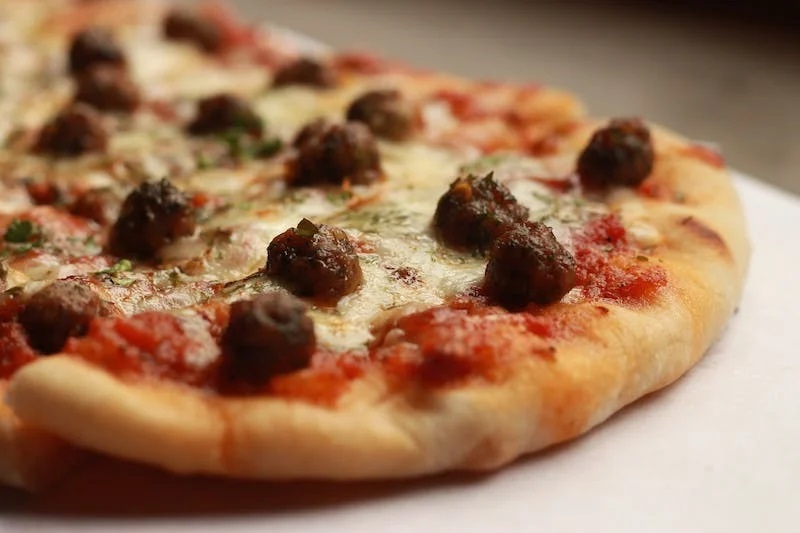Embarking on a homemade pizza journey brings its own set of questions, one of the most common being, “How long does pizza dough last in the fridge?” Whether you’re a seasoned home chef or someone just beginning to explore the world of homemade pizzas, understanding the lifespan of your pizza dough in the refrigerator is crucial. This question isn’t just about longevity; it’s about ensuring that each pizza you bake retains the delightful taste and perfect texture that pizza lovers crave.
Our comprehensive guide delves deep into the essentials of pizza dough storage, drawing on culinary expertise to provide you with actionable insights. We not only answer the pressing question of dough’s fridge life but also share tips on how to recognize when your dough is at its peak freshness. This article is packed with valuable content that will elevate your homemade pizza game, ensuring that your dough remains fresh and your pizzas delicious. Let’s unravel the mystery behind pizza dough preservation, guiding you step by step to achieve that perfect crust every time. Join us as we explore the ins and outs of pizza dough storage, a key ingredient to mastering the art of pizza making.
Pizza Dough Essentials

Before diving into techniques, let’s cover the basics of what pizza dough contains and the options available.
What is Pizza Dough?
The simple beauty of pizza dough belies its complex chemistry. At its core, basic pizza dough contains:
- Flour – Typically all-purpose or bread flour. Provides structure and starch for crust browning.
- Water – Hydrates the flour to form elastic gluten networks. Determines dough hydration.
- Yeast – Leavening agent that produces gas bubbles and dough rise. Adds flavor.
- Salt – Enhances flavor. Strengthens gluten development.
- Sugar or oil – Sometimes added for browning and softness.
The ratios of these ingredients dramatically impact the dough’s characteristics and baking qualities.
Different Types of Pizza Dough
Common pizza dough styles include:
- Neapolitan – Soft, pillowy, higher hydration dough baked at ultra-high temps.
- New York – Crispier, chewier, lower hydration dough typically baked in a deck oven.
- Sicilian – Thicker, focaccia-like dough baked in oiled pans.
- Whole wheat – Nuttier, denser dough with whole grain flour.
- Gluten-free – Dough made from alternate flours like rice or almond.
Nutritional Profile of Pizza Dough
One serving of basic pizza dough (100g) contains approximately:
- Calories – 330
- Carbohydrates – 65g
- Protein – 12g
- Fat – 1g
Whole wheat, multigrain, and gluten-free doughs have slightly varied nutrition profiles. The preparation method also impacts the numbers.
The Science of Perfect Pizza Dough
Achieving that perfect crust requires understanding how various scientific factors interact in the dough.
The Role of Hydration
Hydration refers to the ratio of water to flour in the dough. More water makes a wetter, more extensible dough. Typical hydration percentages are:
- Neapolitan – 60-70% (wet)
- New York – 50-60%
Higher hydration doughs bake up lighter and puffier like Neapolitan pizzas. Lower hydration makes a denser, chewier crust.
Yeast and Fermentation
Yeast produces carbon dioxide gas that causes the dough to rise. Types include:
- Active dry – Most common, requires activation in warm water.
- Instant – Blends with dry ingredients, no proofing needed.
- Fresh – Pre-activated moist yeast, imparts tangy flavor.
Longer fermentation (1-3 days) allows complex flavors to develop. Over-proofing leads to collapsed dough.
Flour Types and Quality
Read on to learn more : How Many Slices Are In A Little Caesar Pizza? | Tatos Pizza
Flour protein content affects dough strength and stretchiness:
- All-purpose (10-12% protein) – Essential for both crust and chew.
- Bread flour (12-14% protein) – Develops more gluten, ideal for chewy crusts.
- Whole wheat (12-15% protein) – Nutty flavor and dense texture.
High quality flours absorb water optimally for perfect dough hydration and rise.
Pizza Dough
How Long Does Pizza Dough Last In The Fridge?
Pizza dough can last in the fridge for at least 3 days and up to 5 days when stored correctly. To extend the shelf life of pizza dough, consider the following factors:
Yeast: The more yeast you add, the faster it ferments and breaks down the flour starches, which can reduce the dough’s longevity.
- Temperature: Using warm water with active yeast instead of cold water when making the dough helps it grow faster but reduces longevity.
- Protein: The more proteins in the flour, the longer the dough will last.
Time to Preserve Pizza Dough in Freeze and Counter
- Freezing – Wrap dough balls tightly in plastic then foil. Keeps for 2-3 months. Thaw overnight before using.
- Counter – Covered dough keeps for 8-12 hours at room temperature.
How to Store Pizza Dough in the Frigde?
To store pizza dough in the fridge, follow these steps:
- Prepare the dough with cold water and let it rise at room temperature for a slower fermentation process.
- Once the dough has doubled in size, cut it into small dough balls (around 200-250 grams per ball).
- Cover each ball in plastic wrap or use a food sealer machine before refrigerating them in an airtight container.
- Cutting back on the amount of yeast you use will significantly increase the dough’s lifespan when storing it in the fridge.
Remember to check the dough before using it. If it has a sour smell, strange texture, or any signs of mold growth, it’s best to throw it away and start fresh.
Advanced Dough Techniques
To maximize flavor, texture and rise try:
- Autolyse – Hydrating flour before adding yeast and salt to rest the glutens.
- Cold ferment – Slow fermentation in the fridge for 1-3 days.
- Windowpane test – Stretching dough thinly to test gluten development.
Maximizing Shelf Life and Quality
With a few tweaks, you can keep dough fresher for longer.
Extending Pizza Dough Life
To prolong shelf life:
- Use ice-cold water and avoid excess warmth during mixing.
- Choose instant yeast over active dry for stability.
- Proof yeast first in water for fresher, tastier dough.
- Knead thoroughly to develop gluten for shelf life.
- Cold ferment dough in the refrigerator.
With care, your dough will stay lively for days.
Troubleshooting Common Dough Issues
Uh oh, your dough isn’t perfect? Try these fixes:
- Dry or stiff dough – Add small amounts of water until right consistency.
- Overproofed – Punch down, knead and reshape if needed.
- Underproofed – Cover and let sit longer before using.
- Dense or leaden dough – Improve with higher protein flour and thorough kneading.
Be patient and keep tweaking until you achieve that ideal airy yet chewy pizza dough texture.
Enjoying Your Dough
Now for the best part – turning your artisanal dough into delicious eats.
Creative Uses for Leftover Pizza Dough
Read on to learn more : How Many People Does a Large Pizza Feed? Happy Guests
Leftover dough keeps on giving. Repurpose it into:
- Focaccia, breadsticks, and bread loaves
- Garlic rolls, cinnamon twists, or pretzel bites
- Quick weeknight calzones or stromboli
- Sweet breads and monkey bread
With basic shaping and baking skills, you can transform leftover dough again and again.
Pairing Your Pizzas
Enhance your homemade pizzas with:
- Bubbly drinks – Consider beer, Prosecco, or soda water.
- Crisp greens – Balances richness. Caesar, spinach, kale, and arugula all work.
- Olive oil drizzle – Good quality olive oil enhances flavor.
- Shaved parmesan – Freshly grated adds a tasty finishing touch.
Thoughtfully chosen beverages, sides and garnishes elevate the experience.
Building the Perfect Pizza Night
To create the ultimate homemade pizza experience:
- Let frozen dough thaw gradually in the fridge overnight before using.
- Set up a pizza assembly line with toppings, sauces, and equipment.
- Preheat oven, pizza steel, or outdoor pizza oven at least 1 hour prior.
- Use cornstarch or semolina flour to prevent sticking when stretching dough.
- Have fun with creative toppings – anything goes.
Keep pizzas coming piping hot for your perfect pizza party. We’ve covered a lot of ground, but no pizza guide is complete without addressing health and sustainability considerations.
Health, Safety and Sustainability

Home pizza-making allows you to control exactly what goes into your dough. But there are still important precautions to take.
Food Safety Tips
When working with raw dough:
- Always wash hands and kitchen surfaces after handling.
- Ensure dough is cooked thoroughly to an internal temperature of 200°F.
- Discard dough kept beyond recommended storage time even if it looks ok.
Properly storing, preparing and cooking your dough prevents foodborne illnesses.
Eco-Friendly Storage Solutions
To reduce waste, opt for reusable storage methods:
- Wash and reuse dough containers instead of disposable bags.
- Let your freezer work double duty by freezing dough directly in rigid containers.
- Allow dough to come to room temperature before placing in compost bin.
With planning, homemade pizza dough can be a very low waste endeavor.
Conclusion: How Long Does Pizza Dough Last In The Fridge?
We’ve covered all the fundamentals, from dough ingredients and prep to storage and troubleshooting. Making pizza dough truly requires an equal blend of science and art. Don’t be intimidated. Start simply then incorporate advanced techniques over time. Keep tweaking your recipe and process until you achieve pizza perfection.
Most importantly, remember that practice is the key to mastery. The more often you craft pizza dough, the more those skills will become second nature. So get mixing, shaping and baking. Document your dough journey and proudly share your creations. Here’s to a lifetime of learning, creativity and deliciousness through the art and science of homemade pizza dough.

Chef John Sebastian has been cooking up a storm at his simple place for years. Offering a variety of international foods, Chef John Sebastian has something for everyone- and he makes it all look easy!
He’s been featured in various food magazines and cooking shows, and his restaurant has become a local favorite in the community. When he’s not in the kitchen, Chef John Sebastian enjoys spending time with his family.
